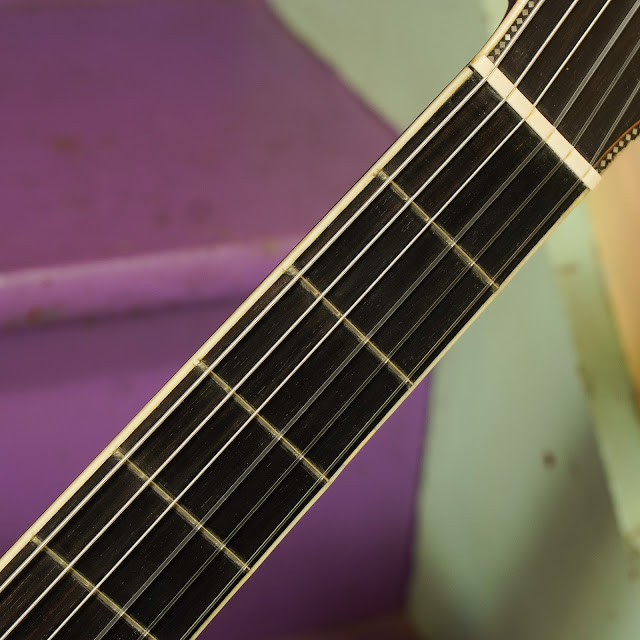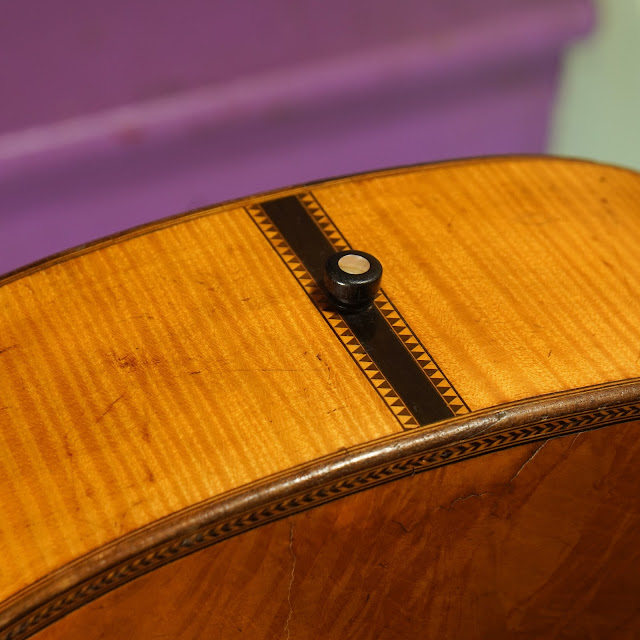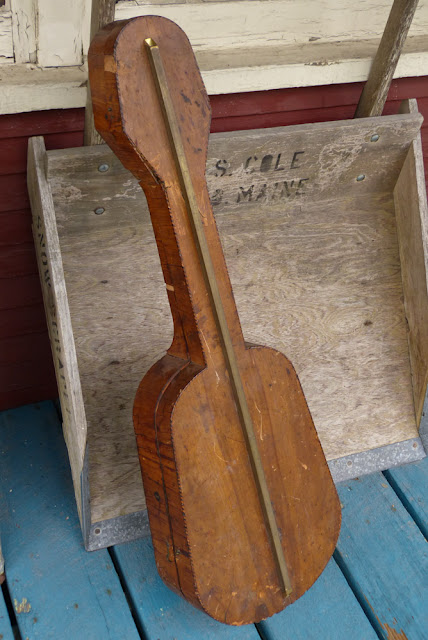1820s Vienna-made (Likely Stauffer) Super-Fancy Parlor Guitar
I have been avoiding writing-up this instrument for over two weeks after finishing-up some recent adjustments on it because I've been wanting to get all of my facts straight about it. I worked on this years ago and was essentially convinced that this is a Johann Georg Stauffer or Stauffer-workshop instrument, made in Vienna, by the fellow who trained "the original C.F. Martin" before Martin came to the States. After reviewing far too much information, I'm even more convinced that this is a Stauffer instrument made around 1820 or so.
Martin would go-on to make his own variation of these instruments before branching-out into styles more familiar to us from the mid-1800s and onwards. There is an incredibly-useful writeup comparing and contrasting an early Martin in this style to (several) same-period Stauffer instruments at Robert Corwin's Vintage Martin site (click to head there). It has ridiculously-valuable interior shots of a Stauffer's bracing and construction (including a very distinctive "buttress" brace running from the neckblock and overlapping the upper-bout top brace) as well as the Martin equivalent which looks much the same.
This guitar's bracing and design (right down to the linings and bridge plate) is a carbon-copy of the interior of the Stauffer, save that this guitar does not have an adjustable heel or bolt plate to accept it. I have not seen a similar neckblock/buttress setup like this in any other period guitar I've worked-on (German, French, American, what-have-you) and bracing styles, plate locations, etc. are often very particular to specific builders in this era. The fact that these all look almost identical under the hood is very suggestive to me. I've included a full set of my own photos of the interior so you can see the similarities and changes via repair over time.
Other details are also extremely close to lots of other Stauffers that appear on the net -- the absurdly-intense ebony/ivory/pearl inlay on the back of the neck and the detail of the "ice cream cone heel" inlay is very close to the two guitars mentioned at the above link (VintageMartin.com's page) and other details like bridge design, tuning machines and coverplates, and cosmetic details all line-up with this speculation.
For example, there are several places on the net to review photos of Stauffer-made instruments. Click here for one. Click here for another. You can search for yourself, too -- it's a wild forest of random examples of these guitars out there to dig through. There are also plenty of other guitars that look similar to this instrument, though this is the fanciest one of this type I've seen on the net so far -- with not much contest. As my buddy Rick put it, "this looks like a king's guitar." It does indeed.
It also sounds like one -- with an open, sweet, warm, and clean voice. It's so lightly-built that I've kept it tuned-down a half step in Eb (closer to an "antique" A=420hz or so) and used light-gauge classical strings on it. Even so, it sounds gorgeous. Playability is also spot-on and fast at 3/32" action height at the 12th fret -- just right for a folk-classical instrument.
This is an example of a Legnani-style guitar from the time, featuring an almost-figure-8 body shape and construction elements that are typical of the type. As noted, it does not have a cantilevered fretboard extension or adjustable heel (like many Legnanis), but the other features of Stauffer-style Legnani-type instruments are all there.
For those not in the know, pin bridges do not equate to steel strings until the 1920s. In this capacity, they're meant for gut strings and the modern equivalent is nylon or fluorocarbon. If you've gotten this far in my description, though, you probably know that already.
Let's talk about construction and features, though...
The bracing on the top is "one ladder above" the soundhole with a buttress that runs through it and connects to the neckblock. There's one ladder "below" the soundhole, a small bridge plate, and then another angled ladder brace below the bridge plate. The back is simply ladder-braced.
The top is solid spruce and very lightly-cut. The sides are solid flamed maple and the figure can be seen on the inside. The back is made-up of a solid interior layer of spruce (just like the soundboard) but with a thin veneer of figured maple laminated to its rear. This is very common for period German, Austrian, and sometimes French guitars of the time. I've seen this application of spruce on backs on several other-make German-made instruments from the 1830s and 1840s.
The neck is most-likely maple but it's painted black so I can't be sure. It has one of the more-complicated inlay patterns I've seen on its rear, featuring inlaid strips of ebony and ivory and "checker" pearl inlay. Triangular "darts" are inlaid into the ice-cream-cone heel. The fretboard and bridge are ebony and binding on the neck is a mix of mostly-original ivory and some replacement plastic. I believe the bridge "wings" with their viney-looking ends are a different wood, however.
Its pearl inlay touches, though, are of course the main feast for the eyes. There's absurdly-detailed floral inlay at the end of the fretboard and at the headstock and soundhole. All of that is engraved profusely. There's also pearl "checker" inlay all around the headstock's edge. The top of the body has yet more engraved inlay all around its edge and there's lines of purfling bordering it. I mentioned the fancy inlay on the back of the neck earlier, but that's also "joined" by a beautifully-engraved tuner backplate.
Under said backplate are original, hand-cut brass tuners with a few older repairs -- a couple of replaced or reinforced "shafts" for the buttons done in the 1800s by their looks and my own repair to a damaged/replaced gear for one of the posts (the A-string unit). I replaced a broken old-replacement gear with a 1920s-era one that's soldered to the post. I cut several replacement brass gears for it before realizing I was tired of having them strip-out and fail on me after a while. It turns-out it's a difficult part to match by hand! This repair has been working well since install.
The repair history before the guitar came to me included some work done by a violin repairman some time ago. He filled dried-up hairline cracks in the top and added some with-grain (grr) cleats to the worst of them just below the soundhole. Those I left as-is as I feared damaging the top removing them. They've been fine. To these repairs, back in 2016 I added a spruce-top-thickness cleat banding a few cracks under the soundhole as well and checked-up on the other old repairs. All of these top repairs have been stable ever since.
My other repairs at the time turned this into a proper player's instrument as well -- without harming the originality one bit. It remains a great, easy player and has been stable in service. The neck is comfortable and quick and suits a folk-style fingerpicker or strummer perfectly, though a classical player will have no trouble with it.
Repairs included: (previously) a fret level/dress, replacement binding for the neck and a tiny bit on the headstock, setup adjustments, cleaning, and one extra cleat for hairline cracks on the top. Currently, I've replaced a tiny bit more binding (one piece had fallen-out), repaired a replacement/damaged gear for the A-string tuner, and adjusted the setup just slightly. It's good to go.
Top wood: solid spruce
Back & sides wood: solid flamed maple sides, figured maple/spruce back
Bracing type: ladder
Bridge: ebony
Fretboard: ebony
Neck wood: maple
Action height at 12th fret: 3/32" overall (quick)
String gauges: EJ43 D'Addario light classical
Neck shape: medium C
Board radius: essentially flat, very slight radius
Truss rod: none
Neck relief: straight
Fret style: low/small
Scale length: 23 7/8"
Nut width: 1 3/4"
Body width: 11 3/4"
Body depth: 3 3/8"
Weight: 2 lbs 11 oz (it's a feather...)
Condition notes: there are a number of repaired hairline cracks and some small splints/fills for them on the top. The bridge pins, sections of binding, one tuner gear, and some of the tuner-plate mounting screws are replacements. Otherwise the guitar is original throughout (even that metal saddle). It shows playwear and usewear from almost 200 years of play but looks grand. There's discoloration and playwear to the top. I'm assuming the top was not finished when it was made or just lightly-sealed as per the custom back then and I'm guessing the top was French polished whenever the violin-style repairs were done to it. In any case, the job is old and it looks great. The very tip of the "ice-cream-cone" heel is missing and there's a small section of fill (rather than purfling/binding) right where the top joins the neck at the body.
It comes with: its original case (to be pictured soon in more detail -- I'm thinking-on how to go about repairing it better -- currently I've got old photos attached) and also a travel-worthy flight-style foam-walled hard case.






















































Comments
This guitar looks and sounds amazing. Your research is comprehensive and definitive. I feel lucky that there are people like you to take care of these amazing artifacts.
Thanks for preserving this piece of history.
DC